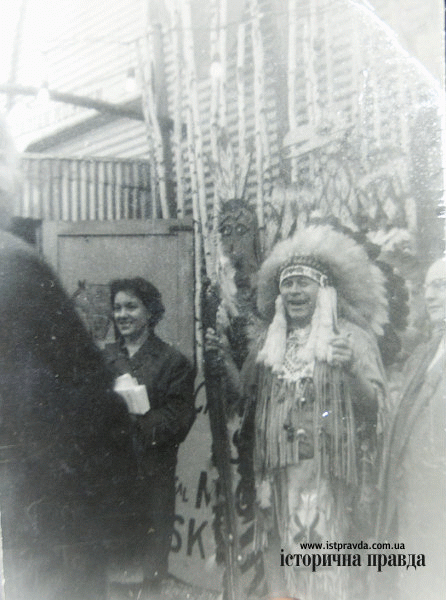blogpost by Ihor Cap
The latest Ukrainian film release "He Who Went Through Fire" or as in the official film trailer's title "Fire Crosser" may be just the blockbuster hit that Ukrainians are wanting to see. Insightmedia Producing Center in cooperation with the Ministry of Culture and Tourism of Ukraine, and specifically the State Service for Cinematography financed this film in the hopes of finding a movie hero that appeals to a wide range of Ukrainian movie goers, a "Ukrainian Rambo" you might say, except a real one and find him they did in the most unexpected of all places, in Montreal, Canada.
Film maker Mykhailo Illienko worked on this full-length feature film several years. It has all the elements of a great cinematic tale. "Fire Crosser" is not a documentary but it is based on historical realities. It's about a highly decorated Soviet Ukrainian squadron leader who is captured by the Germans in WW II and considered missing in action. He manages to escape German captivity and cross impossible front lines to return to his squadron only to be arrested and hauled off to Siberia as a traitor. This time he manages to escape Russian imprisonment and ends up in Canada to become a Mohawk chief all the while maintaining his Ukrainian cultural identity.
The Ukrainian newspaper Istorychna Pravda (Historical Truth) found some pretty convincing evidence to support the movie's main hero Ivan Dodoka (in real life Ivan Datsenko). As it turns out, a famous Soviet Chechen dancer Makhmud Esambayev who performed at Expo 67 in Montreal said he was flabbergasted by the Ukrainian language fluency of this Iroquois who also sang a well known Ukrainian Cossack song Rozpriahaite, khloptsi, koni¦, [Unharness the horses, boys]. Makhmud was part of a Soviet delegation that visited the Indian reservation in Montreal and after meeting this Chief, he made repeated claims that the Chief and Ivan Datsenko are one and the same person, says the January 12, 2012 edition of the daily Ukrainian newspaper Day. Elsewhere it says that Illienko himself only heard of this in 1993 and the story resurfaced again in 2002 in a popular TV program called Wait For Me. On this program, one of Ivan Datsenko's relative's, Olha V. Ruban showed two pictures of her uncle. The first picture was of her uncle receiving the Gold Star, and the second picture was of an Iroquois tribe leader in full battle regalia, war paint, amulets, feathers and all. Incredibly, expert examination of the two photographs confirmed that the individual in the two separate photographs is the same person!
Yaroslav Pidhora-Hviazdovskiy, interviewed the movie director Mykhailo Illienko and asked him where he found information about this little known character? Ilienko explains it in this way:
I've found many investigative reports online. Some confirm his story, others deny it. That's why we put a caption at the end of the film saying, The story is based on the life of a real person... We know that the Germans captured him after his plane crashed and our soviet Hero, like all other prisoners of war, became a soviet antihero. So, Datsenko was sent to other camps, to soviet ones. He escaped. And there trail ends, so we changed his name.
Our character is Ivan Dodoka. We can't use the name of a real person without knowing all details of his life. A branded man, Datsenko had a very simple relationship with society: as a soviet prisoner, a traitor and a runaway, he was on the run. Many years later, he meets a soviet delegation in Canada as chief of an Indian tribe. Nobody knows how he got there. This is our own version, the one I find the most convincing. And it satisfies the crucial impulse without which I wouldn't have started the film.
When he saw the soviet delegation, Datsenko remembered what it was like, running from the NKVD, so when someone asked How did you get here? he said that he had been born here, in Canada, to a Ukrainian immigrant, and met a daughter of an Indian chief later. He married her and inherited the chief's status. The tribe gave him the name, He Who Went Through Fire. Why would a migrant's son have a name like this? What fire did he go through? Despite some assumptions we've had to make, the version in our film is clearly true. In the synopsis to my movie I wrote that a soldier abandoned by his kingdom has a right to choose another king and this is the story of a soldier who became king himself.
Fire Crosser received its first international recognition at the Grand Prix III Kyiv Film Festival. It was released for public consumption on January 12, 2012 but the unusual storyline of the film has already managed to spark further interest abroad in the USA, Canada, Argentina, Poland, Russia, and Mozambique.
Author Information:
Ihor Cap is a Web Author and Dad.
Online References
In English
In Ukrainian
Note: This article first appeared January 27, 2012 in http:/articlesandblogs.ezreklama.com.
Firecrosser: Official Movie Trailer


